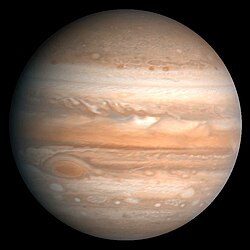Portal:Radiation astronomy/Resource/27
Oranges
[edit | edit source]
"[O]range [is] the color of Jupiter"[1].
The orange and brown coloration in the clouds of Jupiter are caused by upwelling compounds that change color when they are exposed to ultraviolet light from the Sun. The exact makeup remains uncertain, but the substances are believed to be phosphorus, sulfur or possibly hydrocarbons.[2][3] These colorful compounds, known as chromophores, mix with the warmer, lower deck of clouds. The zones are formed when rising convection cells form crystallizing ammonia that masks out these lower clouds from view.[4]
The orange system [in orange astronomy] is a number of emission lines very close together forming a band in the orange portion of the visible spectrum. These lines are usually associated with particular molecular species, including ScO, YO, and TiO.[5]
The orange band from molecular CaCl is "observed in the spectra of many carbon stars."[6]
The Fe VII emission line at 608.7 nm, "frequently observed in the spectra of astrophysical plasmas", has been detected in planetary nebulae, Seyfert galaxies, and quasars.[7]
References
[edit | edit source]- ↑ Faber Birren (Summer 1983). "Color and human response". Color Research and Application 8 (2): 75-81. doi:10.1002/col.5080080204. http://onlinelibrary.wiley.com/doi/10.1002/col.5080080204/abstract. Retrieved 2012-04-23.
- ↑ Elkins-Tanton, Linda T. (2006). Jupiter and Saturn. New York: Chelsea House. ISBN 0-8160-5196-8.
- ↑ Strycker, P. D.; Chanover, N.; Sussman, M.; Simon-Miller, A. (2006). A Spectroscopic Search for Jupiter's Chromophores. American Astronomical Society. Bibcode: 2006DPS....38.1115S.
- ↑ Gierasch, Peter J.; Nicholson, Philip D. (2004). Jupiter. World Book @ NASA. http://www.nasa.gov/worldbook/jupiter_worldbook.html. Retrieved 2006-08-10.
- ↑ G. H. Herbig (March 1974). "VY Canis Majoris. IV. The emission bands of ScO". The Astrophysical Journal 188 (3): 533-8. doi:10.1086/152744.
- ↑ J. E. Littleton and Sumner P. Davis (October 1988). "Transition strength data for the orange and red bands of CaCl". The Astrophysical Journal 333 (10): 1026-34. doi:10.1086/166809.
- ↑ F. P. Keenan and P. H. Norrington (July 1987). "Relative emission line strengths for Fe VII in astrophysical plasmas". Astronomy and Astrophysics 181 (2): 370-2.
